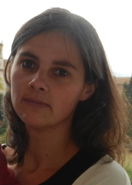Alejandra Recio-Blanco
Galactic Archaeology, chemical abundances, Gaia
office : UMR LAGRANGE Bureau : C1-15
adress : C.I.O.N
Boulevard de l'Observatoire
CS 34229
06304 Nice Cedex 4
phone : +33 4 92 00 30 14
email : alejandra.recio-blanco@oca.eu
Research interests and main results
I am Astronome at the Observatoire de la Côte d’Azur (Lagrange Laboratory). My research interests are Galactic Archaeology, stellar physics and data analysis.
Galactic Archaeology expects to reconstruct the history of the Milky Way by analysing stars, just as the history of life was deduced by examining rocks, Stars record their past in their ages, chemical compositions and kinematics and can provide unprecedented constraints on the early phases of galaxy formation back to redshifts greater than two (a look-back time of about 10 billion years). How did our galaxy form? What is its place and ours in the cosmic evolution? These are part of the questions that my research work tries to unveil.
My research approach is focussed in unveiling the chemical substructure in Galactic stellar populations to understand the Milky Way evolution. With this objective in mind, I developed my own analysis tools. I have tackled the problem of automated stellar parameterisation, of which I have been one of the pioneers, to robustly deal with the large data samples necessary to Galactic studies (see for instance Recio-Blanco et al. 2006; Recio-Blanco et al. 2016). The different algorithms I implemented are now being used by many international projects of Galactic Archaeology, either by myself or my collaborators.
More recently, I have searched this duality among halo populations. First, I concluded that accretion of high-mass satellites could be a major contribution to the current Milky Way globular cluster system (Recio-Blanco, 2018). More recently, I have revealed the heavy elements signature of ancient accreted Milky Way satellites, suggesting that the heavy-element scatter in the halo challenging chemical evolution models since more than 20 years is caused by the mixed contribution of an in-situ and an ex-situ component (Recio-Blanco et al. 2021).
The study of the chemical abundances of Galactic populations has allowed me to reveal the chemical bimodality of the Galactic thin and thick discs outside the solar neighbourhood (Recio-Blanco et al. 2014), and in the Bulge (Recio-Blanco et al. 2017).
Gaia mission work
The recent revolution in Milky Way studies fostered by the ESA Gaia mission, is unveiling a complex Milky Way that is the outcome of an eventful evolution, shaping it to the present day. I am resposible for the estimate of the chemo-physical properties of the stars using Gaia/RVS data. The all-sky Gaia chemical cartography allows a powerful and precise chemo-dynamical view of the Milky Way with unprecedented spatial coverage and statistical robustness.
I am the corresponding author of one of the nine Gaia DR3 performance demostration papers :
"Gaia Data Release 3: Chemical cartography of the Milky Way" Gaia Collaboration, Recio-Blanco, A., et al., A&A 2022
The main results of this study can be found here: https://www.cosmos.esa.int/web/gaia/dr3-what-are-they-made-of
In addition, this video illustrates the Gaia DR3 chemical cartography:
In addition, I am responsible for one of the main processing Gaia DR3 papers, describing the stellar chemo-physical parametrization from Gaia RVS spectra:
"Gaia Data Release 3: Analysis of the Gaia RVS spectra by the General Stellar Parameterizer-Spectroscopy module"
Recio-Blanco, et al., A&A 2022
Responsibilities in international projects
I am heavily involved in the development of large observational projects like Gaia, the Gaia-ESO Survey (GES), the ESO-OCA AMBRE project, RAVE, WEAVE, and MOONS. I have also leading responsibilities in nationally and EU funded scientific projects like ARCHEOGAL (ANR-14-CE33-0014) and EXPLORE (H2020-SPACE-2020, No 101004214).
In particular, my investment in the Gaia Data Processing and Analysis Consortium (DPAC) since its creation is a major commitment of my activities. I am responsible for the stellar parameters, the chemical abundances and the DIB parameters derivation from the Gaia/RVS spectra, managing an iternational group of 12 researchers and engineers: the Generalized Stellar Parameteriser - Spectroscopy (GSPspec) working group. You can see here the recent Gaia Image of the Week that ESA has published to illustrate the GSPspec contribution to the next Gaia DR3.
The AMBRE Project (de Laverny, Recio-Blanco et al.2013) is a collaboration between the Observatoire de la Côte d’Azur (OCA) and the European Southern Observatory (ESO) to automatically and homogeneously parametrise archived stellar spectra from ESO spectrographs: FEROS, HARPS, and UVES. The AMBRE catalogue is available through the ESO webpages. In addition to the catalogue production, the OCA/AMBRE team has already lead the publication of about 20 refereed scientific articles on Galactic Archaeology using the AMBRE data.
In addition, I am P.I of the ARCHEOGAL scientific project funded by the French Agence Nationale de la Recherche (ANR). ARCHEOGAL exploited the Gaia-ESO Survey data (of which I lead the largest spectral analysis Working Group), the Gaia DR1 and DR2 (of which I was co-author as an active DPAC member) and the analysis of the European Southern Observatory spectral archive by the ESO-OCA AMBRE project (of which I am co-PI).
I am responsible for Galactic Archaeology topic of the EU H2020 EXPLORE project, leading the OCA contribution to the consortium. EXPLORE gathers experts from different science domains and technological expertises to develop new tools that will enable and promote the explotiation of space science data. EXPLORE deploys machine learning and advanced visualization tools to achieve efficient, user-friendly, realistic exploitation of scientific data from astrophysics and planetary space missions, as well as from supporting ground-based massive surveys. The Galactic Applications working group, of which I am responsible, aims at the scientific exploitation of Gaia and ground-based data through the study of Milky Way's formation and evolution.
Finally, I am suppervising one Marie Skłodowska-Curie postdoctoral fellowship starting on 1st of June 2022.
I have also being awarded the Advanced Research Programme of Université Côte d'Azur.





